|
|
|
| |
Ibike
Korea People-to-People Program
|
| |
|
| |
|
| |
|
 Photo essay:
Yeongneung Photo essay:
Yeongneung
|
| |
|
Points of Interest: Yeongneung Royal Tombs of King Sejong and
King Hyopong |
| |
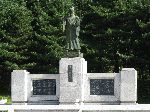 |
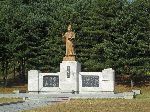 King Sejong (1397-1450)
ascended the throne in 1418 at age 21. He is widely regarded as the most
enlightened king in Korean history. Sejong is best known for his
initiative to create Hanguel, the Korean alphabet. He also invented such
scientific devices as a rain gauge, a celestial globe and sundial, promoted the
development of classical court music, and improved metal type printing
techniques. King Sejong (1397-1450)
ascended the throne in 1418 at age 21. He is widely regarded as the most
enlightened king in Korean history. Sejong is best known for his
initiative to create Hanguel, the Korean alphabet. He also invented such
scientific devices as a rain gauge, a celestial globe and sundial, promoted the
development of classical court music, and improved metal type printing
techniques. |
| |
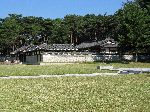 |
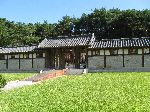 The
Jaesil is where the officiators stayed to prepare for the memorial rites. It
is located outside the Hongsalmun (red gate). The ritual complex is
composed of several buildings, specifically; Anhyangcheong (Hall of Blessed
Comfort), Jegigo (Storage Room for Ritual Vessels), Jaesil (Shrine House), and
Haengnangchae (Caretaker's House). The
Jaesil is where the officiators stayed to prepare for the memorial rites. It
is located outside the Hongsalmun (red gate). The ritual complex is
composed of several buildings, specifically; Anhyangcheong (Hall of Blessed
Comfort), Jegigo (Storage Room for Ritual Vessels), Jaesil (Shrine House), and
Haengnangchae (Caretaker's House). |
| |
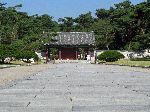 |
 Gate into the King Sejong
tomb area. Gate into the King Sejong
tomb area. |
| |
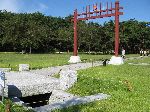
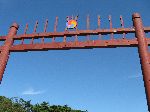 |
In front of the Joseon royal tombs is a eogu (royal channel or stream) or
Geumcheon (forbidden river) which is cross by a Geumcheongyo (forbidden river
bridge). This bridge is typically located in front of the Hongsalmun (red
arrow gate), Traditionally the Geumcheongyo Bridge was built to mark a sacred
zone on the border between the inner and the outer world where the King's spirit
resides. The location of the bridge also represents an auspicious site as
defined by the pungsu (feng shui), which is characterized by gentle hills at the
back and a waterway with low-lying fields at the front. According to a
related pjungsu principle, water prevents fierce land energy flows from the
mountains from making further progress. The Hongsalmun is a memorial gate
standing at the entrance to the tomb sanctuary. It is built with two red posts
and an arrow-like spike on top. The arrow symbolizes the integrity of the law
and the sovereignty of the state. The Hongsalmun is a gate that indicates
the beginning of the sacred area. |
| |
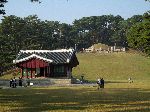 |
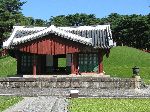 Jeongjagak
is at the base of the hill, in front of the tomb. It is so called because it is in the shape of the Chinese letter jeong,
similar to a "T". Memorial services for the King are held here, with food offerings placed on
the altar table in the jeongjapak.. Jeongjagak
is at the base of the hill, in front of the tomb. It is so called because it is in the shape of the Chinese letter jeong,
similar to a "T". Memorial services for the King are held here, with food offerings placed on
the altar table in the jeongjapak.. |
| |
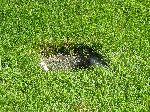 |
The Yagam is a square stone box where, after the completion of the memorial
rites, the invocation paper was burned while the food offerings were being
removed. It is always located to the rear west of the Jeongjagak. |
| |
 |
To the right of the Jeongjagak is the Subokbang, the storehouse for ritual
vessels and also the living quarters for a grave keeper, or subok, a government
slave who kept the tomb complex clean. |
|
|
The
tomb is on a gentle hills with a waterway and low-lying fields at the front. It
is surround with stone figures of civil officials, stone animals, stone lanterns
and zodiac figures. |
| |
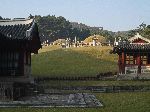 |
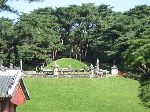
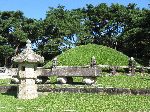
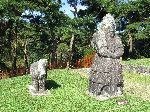
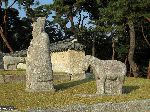 |
| |
|
Also on the site is an exhibit of replicas of
King Sejong Academic Academies scientific achievements. |
| |
 |
The Hansang (celestial globe) is an astronomical instrument designed to observe
a location of constellations via a spherical surface where the constellations
are marked with equatorial and ecliptic coordinates. The axis by which the globe
rotates is designed to correspond to the earth's axis of rotation. The celestial
globe was designed to rotate once a day automatically via the pressure of water
flowing from above. With this instrument officials were able to measure
time during the night and the year's seasonal change. The first one was
installed in 1437. |
| |
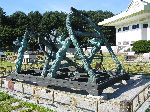 |
The Ganui (armillary sphere) is Joseon's main astronomical instrument. It
measures the time day and night. It was inspired by Yuan astronomer Guo
Shoujing, who invented it in 1276 to observe the sun, moon, five planets and
other stars. In 1432 the Joseon made a wooden armillary sphere and used it
to calculate the latitude of Seoul. This was followed by the production of a
bronze Ganui. |
| |
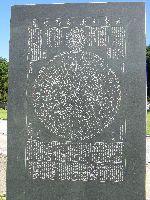 |
This reproduction of a Joseon Cheonsangyeolchabunyajido (astronomical chart)
features constellation according to the twelve divisions of the ecliptics and
the areas on earth corresponding to them. The inscription on the front face of a
black stone was made in 1395, and that on the rear in 1433. The chart consists
of a record of the sun and moon placed on top, 1,467 stars inscribed in a circle
located in the middle, and the chart's title, historical background, the
producer's name and the date of production on the lower part. |
| |
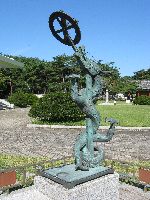 |
The Ilseongjeongsiui (sun-star armillary clock) was made in 1437, by a group of
astronomers led by Yi Cheon and Jang Yeong-sil, as part of an effort to
calculate time via combining the functions of a sundial and star clock.
The instrument consists of four rings and a metal axis which were made according
to the latitude of Seoul calculated at the time. |
| |
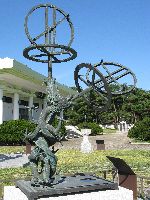 |
This Soganui (small armillary sphere) is an astronomical instrument used to
observe the location of heavenly bodies. Three astronomers, Ye Cheon,
Jeong Cho and Jeong Inji made two small armillary sphere in 1434. Smaller
in size than Ganui, the small armillary sphere was more portable and marked a
simpler structure consisting of three rings, an alidade and a stand. It
was a multi-functional instrument that could also be used as an equatorial
coordinate system and horizontal coordinate system for the calculation of the
location, height and direction of the sun, moon, planets and other stars. It is
known as the world's only instrument of its kind. |
| |
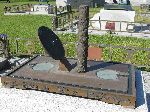 |
Cheonpyeong Ilgu (equilibrium sundial) is one of several sundials made in 1437.
A cord is fastened to connect the 'dragon pillar' with a nail in the south,
perpendicularly crossing the middle of the dial, installed to correspond to the
equatorial plane of the sphere. You can read the time by where the cords shadow
falls on the dial. The dial has two faces, one for summer and one for winter.
The reproduction is seven time larger than the original. |
| |
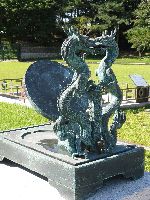 |
This Hyeonju Ilgu (dangling-bead sundial) was created in 1437. It is designed to
measure time via the marks on the dial indicated by the shadow of a cord fastened
tightly in the direction of the earth's axis. The dial has two faces, one for
summer and one for winter. They are used from equinox to equinox. The
reproduction is seven time larger than the original. The originals were fairly
small and used as portable instruments. |
| |
 |
Jeongnam Ilgu (self-striking water clock) I am still working on the cogent parts
of the description for this instrument. If you would like to try your hand at it
here is the site description, "This Wind Flag Pedestal sundial made in 1437, is
designed to measure time by deciding due south even without a magnetic needle.
The axis of Syuhwan ("ring of four displacements") linking south and north posts
is made to correspond to the sphere's north pole and have the sundial level off
with a weight appended to the end of the axis. The Jipyeonghwan ("horizontal
ring") is marked with calibrations representing 24 directions and 24 solar terms
while the Sayuhwan has notch marks designed to help measure the 24 solar terms
and time of the day from sunrise to sunset. You can read time from a
sundial marked with lines representing times and solar terms through a square
hole when a sunray reaches on the dial through the alidade's southern hole as
you move the Sayuhwan and the alidade from side to side and from south to north,
respectively." ref 9315 |
| |
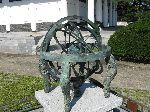 |
The Honcheonui (celestial globe) is an astronomical instrument used to measure
the location of the sun, moon and five planets. This reproduction is 2.5 times
larger than a more advanced Honcheon Sigye, that incorporated clockworks, made
in 1669. |
| |
 |
The Jeokdoui (equatorial telescope) was made by an astronomer named Nam
Byeong-cheol, who combined the Ganui and Honcheonui, two of the dynasty's
greatest astronomical instruments. The Jeokdoui is regarded as the easiest to
use and most efficient. To observe celestial bodies with this instrument, one
needs to decide the direction of the target by arranging the Sayuhwan (ring of
four displacements) and read the related marks through the two holes of the
Gyuhyeong (alidade). |
| |
 |
The Gyupyo (gnomon) is an instrument designed to calculate the days of a year
(i.e. 365 1/4 days) and the 24 solar terms. Consisting of an erected rod
and a calibrated ruler laid horizontally, the instrument helped to know both the
winter and summer solstices, the spring and autumn equinoxes and 20 solar terms
arranged by a gap of 15 days between each term. |
| |
 |
The Angbu Ilgu (upturned cauldron sundial) has been the most widely used sundial
in Korea since the invention in 1437. The gnomon is designed to indicate
24 solar terms from the winter solstice to the summer solstice and the time. |
| |
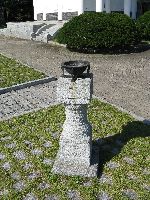 |
The Ilgudae (sundial pedestal), as named, is a pedestal with a sundial on it.
These were installed in public in Seoul to help people know the time. The hour
markers on the sundial are the twelve zodiac animals so that people, who were
largely illiterate, could easily tell time. |
| |
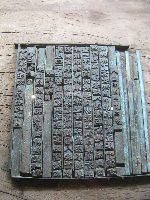 |
This is an example of the
movable type developed during the reign of King Sejong. It was centuries
before Guttenberg would do the same in Europe. |
| |
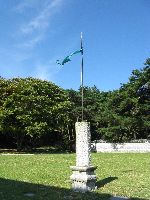 |
The Punggidae (wind flag pedestal) is an instrument with a flag to measure the
direction and speed of the wind. It was part of an effort to get information on
rain and wind that would be helpful in increasing agricultural development. |
| |
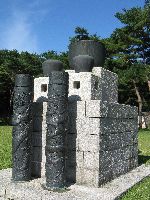 |
The Jagyeongnu (self-striking water clock) was developed by a group of court
researchers led by Jang Yeong-sil, in 1434. This water clock is designed to tell
the time automatically. The mechanism consists of three jars that send
water to a pair of cylindrical receptacles. Floating devices rise
according to the water flow. As they rise they indicate the time by strike
a bell, drum and gong. |
| |
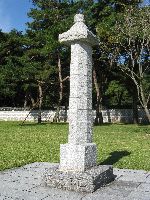 |
Supyo (water gauge) were installed on the major waterways of the capital to
measure river levels around 1441 and 1442. The development of water gauges and
rain gauges was the result of an effort to control floods via systematic
research of the natural environment. The first water gauge was a simple
wooden post with notch marks to show water levels. The wooden post was
later replaced with a stone post. |
| |
 |
This Cheugugi (rain gauge), invented in 1441, by a group of court researchers
led by Jang Yeong-sil, is known as the world's first rain gauge. Records say
that King Sejong, who had found the traditional method of gauging rain was
inaccurate, encouraged his engineers to develop a new, more scientific means of
gauging rain fall. Records also show that the iron rain gauge used in the
capital were extensively copied in the provinces, where the gauges were made of
ceramic. |
| |
|
Royal tomb of King Hyojong
(1619-1659)
and Queen. As a prince the king had been humiliated by the Manchurian Qing
Dynasty when he was held hostage. As king he enforced land tax reform and
encouraged the use of currency as a means of exchange, which contributed to the
development of commerce and industry -- activities generally frowned upon by the
Neo-Confucians. He also built fortresses and increased the training of soldiers
to address threats from the Qing. King Hyojong died before he could carry
out his plan to take revenge on the Qing. The site was repaired and landscaped
in 1977. |
| |
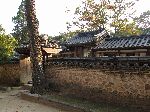 |
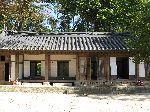
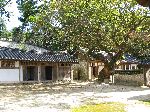
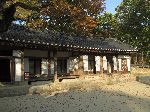 The Jaesil
complex is where
the officiators stayed to prepare for the memorial rites and for the storage of
sacrificial vessels. It is located outside the Hongsalmun (red gate). The
ritual complex is composed of several buildings, specifically; Anhyangcheong
(Hall of Blessed Comfort), Jegigo (Storage Room for Ritual Vessels), Jaesil
(Shrine House), and Haengnangchae (Caretaker's House). The Jaesil
complex is where
the officiators stayed to prepare for the memorial rites and for the storage of
sacrificial vessels. It is located outside the Hongsalmun (red gate). The
ritual complex is composed of several buildings, specifically; Anhyangcheong
(Hall of Blessed Comfort), Jegigo (Storage Room for Ritual Vessels), Jaesil
(Shrine House), and Haengnangchae (Caretaker's House). |
| |
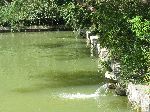 |
Pond at King Hyojang's
tomb |
| |
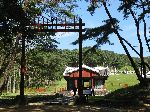 |
The Hongsalmun is a
memorial gate standing at the entrance to the tomb sanctuary. It is built with
two red posts and an arrow-like spike on top. The arrow symbolizes the integrity
of the law and the sovereignty of the state. The Hongsalmun is a gate that
indicates the beginning of the sacred area. |
| |
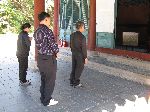 |
The Jeongjagak is where
memorial services are held here, with food offerings placed on the altar table.
People will also come to the Jeongjapak to pay their respect to the sovereign by
making three half bows of respect. |
| |
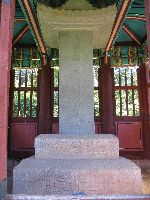 |
The inscription on this stele explains that King Hyojong's tomb was originally
located in the Dongguneung tomb compound in Yangju but was moved here in 1673
and that his wife, Queen Inseon, is buried in a separate grave in front of his
tomb.
It is believed that the stele and its shelter were erected at the time the
tomb was move here. |
| |
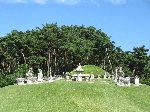 |
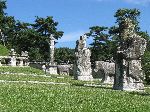
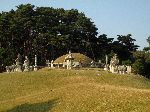
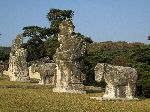 The
tomb is on a gentle hills with a waterway and low-lying fields at the front. It
is surround with stone figures of civil officials, stone animals, stone lanterns
and zodiac figures. The
tomb is on a gentle hills with a waterway and low-lying fields at the front. It
is surround with stone figures of civil officials, stone animals, stone lanterns
and zodiac figures. |
| |
|
|
| |
Yeosu

 Chungju Chungju |
|



 |
 |
|
|
 Please
contact us if you would like to be added to
Ibike's mailing list or have questions, comments, corrections or criticism. (Also, please let us know how you learned about us and
found this site.) Privacy policy. Please
contact us if you would like to be added to
Ibike's mailing list or have questions, comments, corrections or criticism. (Also, please let us know how you learned about us and
found this site.) Privacy policy.
 IBF Homepage
IBF Homepage  Ibike Programs
Ibike Programs
 Ibike Schedule
Ibike Schedule
 Search
Search
"Hosted by
DreamHost - earth friendly web hosting"
Created by David Mozer
Copyright ?1993-2018 Ibike LLC. All rights reserved.
|
 Photo essay:
Yeongneung
Photo essay:
Yeongneung
 King Sejong (1397-1450)
ascended the throne in 1418 at age 21. He is widely regarded as the most
enlightened king in Korean history. Sejong is best known for his
initiative to create Hanguel, the Korean alphabet. He also invented such
scientific devices as a rain gauge, a celestial globe and sundial, promoted the
development of classical court music, and improved metal type printing
techniques.
King Sejong (1397-1450)
ascended the throne in 1418 at age 21. He is widely regarded as the most
enlightened king in Korean history. Sejong is best known for his
initiative to create Hanguel, the Korean alphabet. He also invented such
scientific devices as a rain gauge, a celestial globe and sundial, promoted the
development of classical court music, and improved metal type printing
techniques.
 The
Jaesil is where the officiators stayed to prepare for the memorial rites. It
is located outside the Hongsalmun (red gate). The ritual complex is
composed of several buildings, specifically; Anhyangcheong (Hall of Blessed
Comfort), Jegigo (Storage Room for Ritual Vessels), Jaesil (Shrine House), and
Haengnangchae (Caretaker's House).
The
Jaesil is where the officiators stayed to prepare for the memorial rites. It
is located outside the Hongsalmun (red gate). The ritual complex is
composed of several buildings, specifically; Anhyangcheong (Hall of Blessed
Comfort), Jegigo (Storage Room for Ritual Vessels), Jaesil (Shrine House), and
Haengnangchae (Caretaker's House).
 Gate into the King Sejong
tomb area.
Gate into the King Sejong
tomb area.


 Jeongjagak
is at the base of the hill, in front of the tomb. It is so called because it is in the shape of the Chinese letter jeong,
similar to a "T". Memorial services for the King are held here, with food offerings placed on
the altar table in the jeongjapak..
Jeongjagak
is at the base of the hill, in front of the tomb. It is so called because it is in the shape of the Chinese letter jeong,
similar to a "T". Memorial services for the King are held here, with food offerings placed on
the altar table in the jeongjapak..



























 The Jaesil
complex is where
the officiators stayed to prepare for the memorial rites and for the storage of
sacrificial vessels. It is located outside the Hongsalmun (red gate). The
ritual complex is composed of several buildings, specifically; Anhyangcheong
(Hall of Blessed Comfort), Jegigo (Storage Room for Ritual Vessels), Jaesil
(Shrine House), and Haengnangchae (Caretaker's House).
The Jaesil
complex is where
the officiators stayed to prepare for the memorial rites and for the storage of
sacrificial vessels. It is located outside the Hongsalmun (red gate). The
ritual complex is composed of several buildings, specifically; Anhyangcheong
(Hall of Blessed Comfort), Jegigo (Storage Room for Ritual Vessels), Jaesil
(Shrine House), and Haengnangchae (Caretaker's House).






 The
tomb is on a gentle hills with a waterway and low-lying fields at the front. It
is surround with stone figures of civil officials, stone animals, stone lanterns
and zodiac figures.
The
tomb is on a gentle hills with a waterway and low-lying fields at the front. It
is surround with stone figures of civil officials, stone animals, stone lanterns
and zodiac figures. Please
contact us if you would like to be added to
Ibike's mailing list or have questions, comments, corrections or criticism. (Also, please let us know how you learned about us and
found this site.) Privacy policy.
Please
contact us if you would like to be added to
Ibike's mailing list or have questions, comments, corrections or criticism. (Also, please let us know how you learned about us and
found this site.) Privacy policy.![]() IBF Homepage
IBF Homepage ![]() Ibike Programs
Ibike Programs
![]() Ibike Schedule
Ibike Schedule
![]() Search
Search


